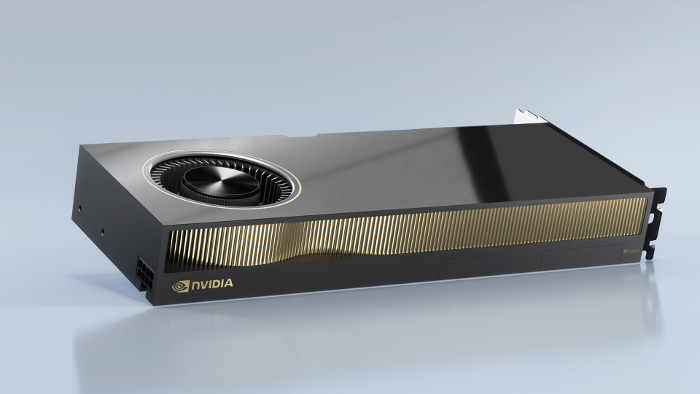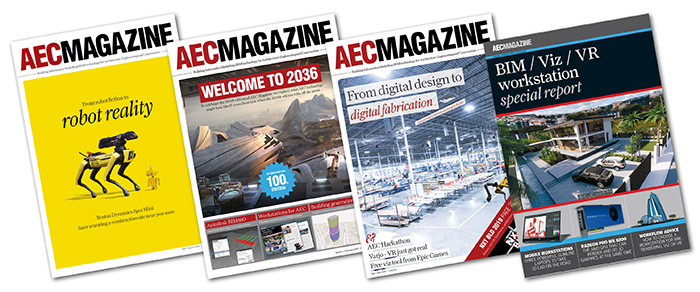Professional GPU promises 2x performance increase over RTX 6000 for GPU rendering and other graphics workflows
The new Nvidia RTX A6000 workstation GPU promises to deliver more than double the GPU rendering performance of its predecessor, the Quadro RTX 6000. In the product design-focused rendering software Luxion KeyShot the performance increase could be 255% or even more, says Nvidia.
Update 22/2/21 – Read our in-depth review of the Nvidia RTX A6000
Professional users can also expect a significant boost in graphics, VR, and AI workflows in sectors including product design, automotive design, and architectural visualisation.
The Nvidia RTX A6000 is the first professional GPU to be built on the Nvidia Ampere architecture. It is also the first to support PCIe Gen 4, in workstations such as the Lenovo ThinkStation P620, which features the new AMD Threadripper Pro CPU.
The Nvidia RTX A6000 is expected to be the top-end model in the range and will be available in December. Replacements for the mainstream Quadro RTX 4000 and RTX 5000 will likely come next year but Nvidia would not be drawn on any details.
The Nvidia RTX A6000 features 48 GB of GDDR6 GPU memory, double that of the Quadro RTX 6000, plus significantly improved processing cores, delivering a ‘2x performance per watt increase’.
According to Nvidia, a total of 84 second-generation RT cores deliver up to 2x the throughput of the pervious generation, plus concurrent ray tracing, shading and compute. Meanwhile, 10,752 new CUDA cores deliver up to 2x the FP32 throughput for significant increases in graphics and compute, while a total of 336 third-generation Tensor Cores provide up to 5x the throughput in AI workflows.
Other specifications include four DisplayPort 1.4 connectors, support for Framelock and NVlink, and a max power consumption of 300W.
Early adopters of the Nvidia RTX A6000 have reported significant benefits in a range of workflows. Car manufacturer Renault, who uses Quadro to review design concepts in ray-traced photorealism, has reported performance gains of over 2x with ray-traced exterior scenes.
Predator Cycling, which specialises in custom carbon bicycles, has seen performance gains of 2-6x across a number of key applications, including Luxion KeyShot and Ansys Discovery CFD. “The real power is that our team can run CFD analysis, be modelling and screen-sharing on a video call, all simultaneously,” said co-founder Aram Goganian.
Kohn Pedersen Fox, one of the world’s largest architecture firms, has noted the ability to triple the resolution and accelerate real-time visualisation of complex building models in cityscapes.
The Nvidia RTX A6000 is focussed very much on graphics. It does not have accelerated double precision performance, which is important for applications including engineering simulation. Nvidia told DEVELOP3D that for customers that need double precision there’s the Quadro GV100 or Nvidia A100 for the data centre.
The Nvidia RTX A6000 is primarily a GPU for desktop workstations, but support for vGPU Software including Nvidia GRID, Nvidia Quadro Virtual Data Center Workstation, and Nvidia Virtual Compute Server, will come next year. vGPU profiles will be available for 1 GB, 2 GB, 3 GB, 4 GB, 6 GB, 8 GB, 12 GB, 16 GB, 24 GB and 48 GB.
Nvidia has also released a new datacentre GPU, the Nvidia A40, which is almost identical to the Nvidia RTX A6000, but is passively cooled.

Nvidia RTX A6000-based workstations are expected from BOXX, Dell, HP and Lenovo and others, while Nvidia A40-based servers are expected from Cisco, Dell, Fujitsu, Hewlett Packard Enterprise, Lenovo and more. Pricing was not disclosed.
If you enjoyed this article, subscribe to our email newsletter or print / PDF magazine for FREE







